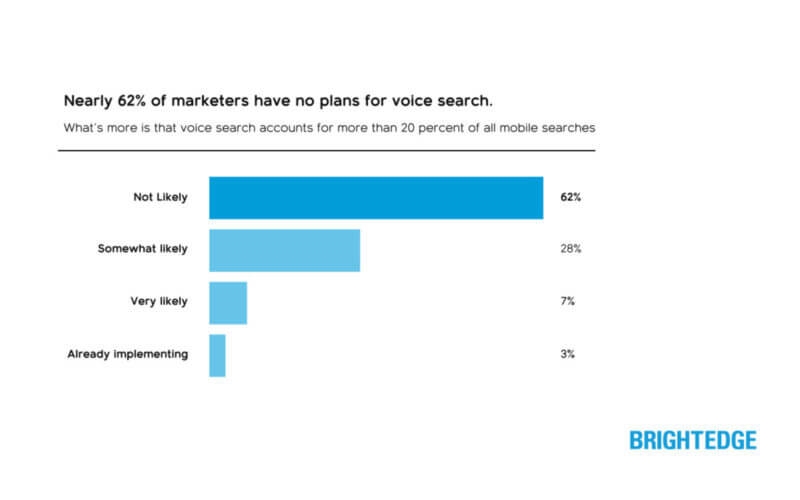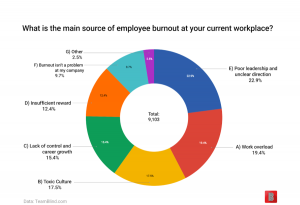Voice search is growing in popularity, yet many search marketers still don’t have a plan for it. Columnist Jim Yu discusses the state of voice search and provides some tips for marketers looking to the future.
Voice search, the topic that is on the virtual tip of every marketer’s tongue, currently accounts for one out of every five Google mobile searches — and that number is expected to grow over time as digital assistants and smart home devices become more commonplace. For the modern-day SEO, the shift from manual text queries to voice commands has been subtle over time, but the potential impact over the next few years could be game-changing.
To prepare for the voice search revolution, it is essential that marketers understand the difference between market growth and consumer adoption, the nuances of conversational search and natural language and the role that AI and machine learning play in SERP responses. Just as with any emerging trend in our industry, it is important to plan now to ensure you stay one step ahead of the search curve.
Trend and adoption
All major technology providers, not just Google, are investing in virtual assistants — and by extension, voice search. Google has Google Assistant, Apple has Siri, Amazon has Alexa, Microsoft has Cortana and Samsung has their new Bixby.
These voice-enabled digital assistants are playing an increasingly larger part in consumers’ everyday lives. For example, on your way to work, you may use voice commands to send messages, listen to mail or navigate via your in-car system. At work, you may use voice search on your Mac (Siri) or PC (Cortana) to manage your schedule. And when you get home, Amazon Echo or Google Home may help you choose your favorite TV show or film on Netflix.
The consumer and marketer disconnect
While voice search is becoming part of consumers’ everyday lives, many marketers still don’t have a plan for voice search. This disconnect may indicate that while consumers are ready, marketers may not be fully prepared. According to research from BrightEdge (disclosure: my company), 31 percent of marketers see voice search as the next big thing. However, approximately 62 percent have no plans to prepare for voice search.

(PRNewsfoto/BrightEdge)
These findings suggest that marketers can see the consumer trend but are not prepared. If they don’t address the trend, brands will not meet their consumers’ expectations.
Bridging the gap and connecting the dots
To capitalize on the opportunity and bridge the gap to meet consumer expectations, it is vital to understand the relationship between voice, mobile and local — and to adapt your optimization strategies accordingly.
Below, I share some insights on voice search and provide some optimization tips.
Conversation and intent
One of the biggest mistakes a marketer can make with voice search concerns intent. In many of my previous articles, I have gone into deep detail on the importance of understanding intent, leveraging intent signals and optimizing for the user accordingly. With voice search, understanding intent becomes even more important, and navigating the nuances is critical to success. The rise in conversational search is one of the main reasons voice search is on the rise.
In fact, Google reports that 70 percent of the queries that Google Assistant receives consist of natural language — in other words, a searcher is speaking to their digital search device in the same way that they would ask a question of another person. This is very different from the way they interact with a text search box. Compared to traditional text search over the last 10 years — where marketers’ focus was on keywords and their implicit meanings — voice search queries are more conversational in nature and can reveal new levels of intent.
For example, when looking for a restaurant with text search, I may type in, “lunch in San Mateo.” When I use voice search, my query may change to, “What restaurants are open in San Mateo?” or “What restaurants are open now for lunch?” Voice search queries are longer than their text-based counterparts and normally focus around “who,” “what,” “where,” “when,” “why” and “how.” What’s more, according to Google’s Mariya Moeva, voice searches on Google are 30 times more likely than text searches to be action queries.
Mobile, local and machine learning
Voice, mobile and local search are on a path to convergence. Mobile devices have disrupted search by giving users the ability to perform on-the-go local queries, and the artificial intelligence behind voice search is introducing new methods of query and different experiences for users.
It is important to note that a key difference between text and voice search is that when a person activates voice search, what is considered the best answer is normally the only answer. So it is a winner-take-all search result. I think this increases the importance of SEO skills and bodes well for its skilled practitioners.
Voice search makes it even easier for customers to ask hyper-local queries, which is significant in the context of a mobile-rich environment. As a marketer, it is important to consider how users execute search queries differently when speaking to mobile devices versus exploring the web via a desktop computer. Voice searches tend to contain slightly different words, such as “close” or “nearby,” which are not commonly used on desktop computers.
The combination of hyper-local targeting, artificial intelligence and machine learning plays an important role in the development and accuracy of voice search. Artificial intelligence (AI) is based on the notion that machines will be able to carry out tasks in a smart and intelligent manner, while machine learning is the application and use of AI as machines gain access to more and more data and learn from themselves. Back in 2013, the Google Hummingbird update signified a shift in how the search engine tried to understand the intent behind a consumer’s query, and RankBrain was introduced in 2015 as the machine learning layer that took AI’s natural language processing to a new level.
Artificial intelligence and machine learning are powering voice search, and this means that with every voice search and every query, Google is getting better at understanding intent. Add to this local data points (on location-enabled devices, for example), and geolocation becomes an automatic part of the query answer. The outcome is that results become more accurate, actionable and transactional in their delivery.
Content and context
Based on personal preferences and recognized patterns of behavior, the artificial intelligence that is powering voice search results will get incrementally better at understanding the context behind a query and providing the relevant content to support the answer. This leads to a very important point that marketers must note when optimizing for voice search: semantics matter greatly.
The future success of search is reliant on providing consumers with an excellent user experience. To do that, marketers must become more intelligent in how they produce content. Content should be structured and written so as to provide traditional SEO value and ensure that a voice engine recognizes and understands the content’s context and meaning. Writing content that answers the questions your consumers are asking in a natural, conversational tone is the best way to prepare for voice search.
Understanding the nuances of conversational search queries can help you discern consumer intent and make sure that your website contains the right content to adapt to voice search. As technology providers find more and more ways to improve user experiences and interactions from voice search, content and context will replace keywords.
Optimizing for voice search
Though voice search may still be years away from being fully mainstream, it already has enough traction for us to begin taking it seriously. While technology works out how to monetize voice search, marketers should be planning at least a year in advance.
Below, I leave you with four key steps you can take when looking at voice search consumer adoption and optimizing for voice search success.
- Step 1: Think conversational intent.
Remember that voice search queries differ from traditional text search queries in terms of how they are structured — the former is more conversational in nature. Expand your view of searcher intent based on the types of question-based queries a user might ask via voice search. It’s essential to deliver more accurate results based on the anticipated context.
- Step 2: Target the long tail.
The question words — who, what, where, why, when and how — have been strongly associated with voice search queries, as they are conversational in nature. Brands should take the time to find long-tail keyword phrases that use these question words, and start developing content tailored for those using voice search. Develop site content and expand your keyword lists (organic and paid) to target longer-tail keyword phrases.
- Step 3: Master mobile and go local.
With the incredible overlap between mobile and voice search, making sure that all content has been prepared for mobile devices is a crucial step towards optimizing for voice. This includes using mobile-friendly layouts, but also optimizing for speed and preparing mobile-optimized content.
If you are a local business, ensure that you complete all the local business listings for your company’s physical locations. Furthermore, ensure that each listing of your business is accurate and complete across Google, Yelp, Bing, Apple Maps and other relevant services.
- Step 4: Build and structure content, and utilize semantics.
Write content in a conversational manner, and think about natural-language processing. Build content that answers questions quickly. Make sure structured data markup is integrated into your website where appropriate. When consumers are searching on their phone, Alexa or another device, your goal is to answer these questions with written content focused on long-tail topics as a part of a greater mix of content included on your site.
Conclusion
Voice search is still developing, and its true potential may be several years away. Technology titans such as Google, Amazon, Microsoft, Apple and Samsung are rapidly innovating with new ways to utilize data and represent voice search results across multiple personal, work and home devices. In addition, they are working out new ways to monetize the voice search phenomenon without disrupting the user experience.
Consumer trends are currently outpacing marketing preparation. To meet customer expectations, search marketers should start developing a plan for voice search now.
[Article on Search Engine Land.]
Some opinions expressed in this article may be those of a guest author and not necessarily Marketing Land. Staff authors are listed here.
Marketing Land – Internet Marketing News, Strategies & Tips
(63)










